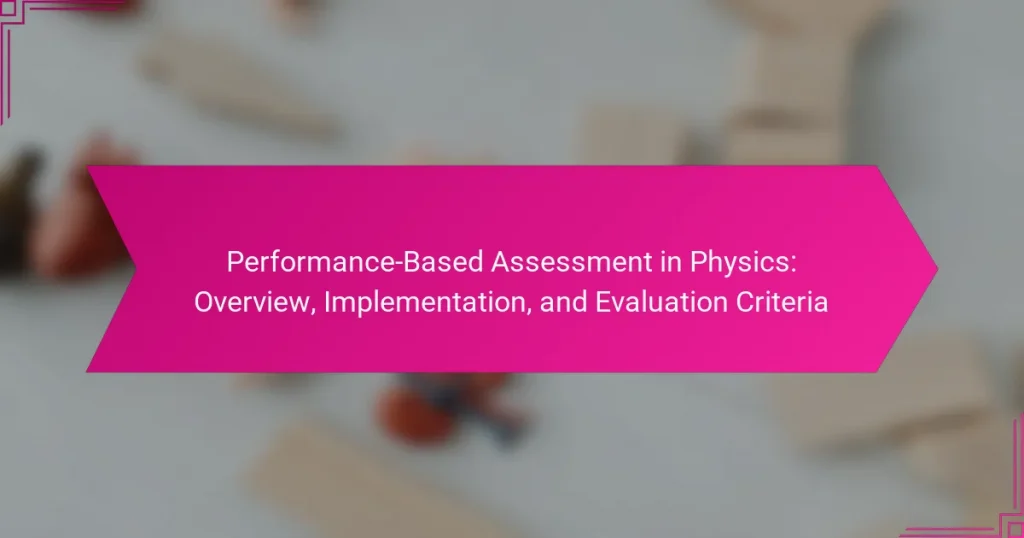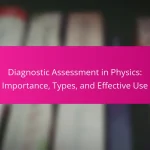Performance-Based Assessment in Physics is an evaluation method that gauges students’ understanding through practical tasks, emphasizing the application of knowledge in real-world contexts. This assessment approach includes hands-on experiments, projects, and simulations that foster critical thinking and problem-solving skills. The article explores the implementation of performance-based assessments in physics classrooms, highlighting the importance of designing tasks that require students to demonstrate their understanding of physics concepts. Additionally, it details the evaluation criteria used to assess students, focusing on accuracy, communication, problem-solving abilities, and adherence to safety protocols. Research findings indicate that this method enhances student engagement and improves retention of physics concepts compared to traditional testing methods.
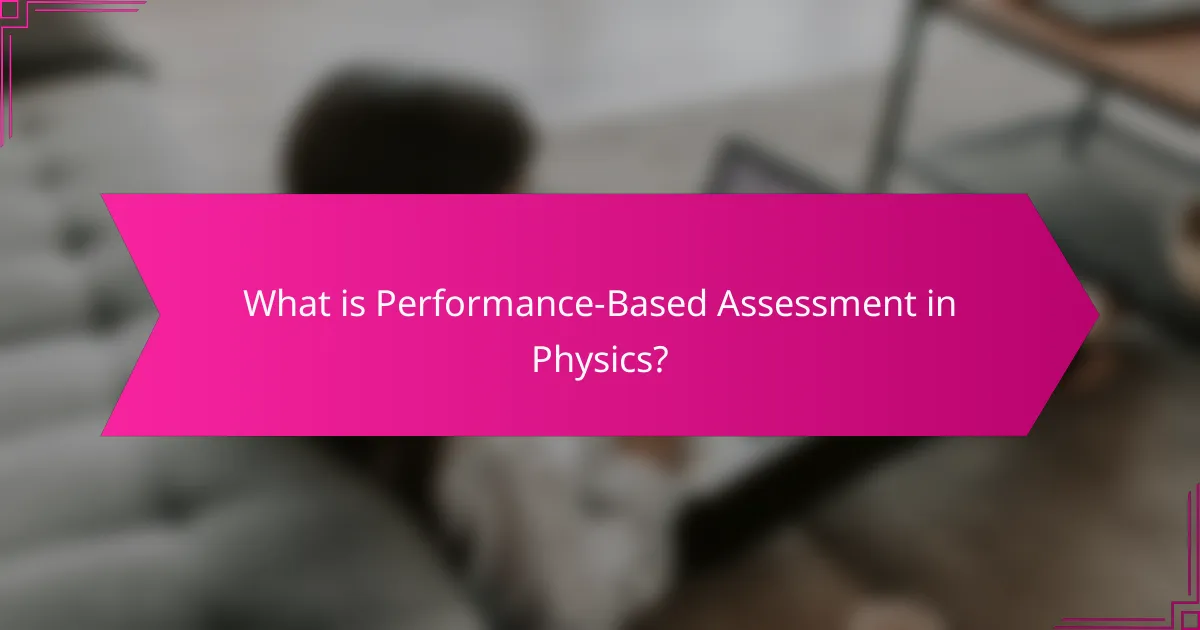
What is Performance-Based Assessment in Physics?
Performance-Based Assessment in Physics is an evaluation method that measures students’ understanding through practical tasks. This approach focuses on students demonstrating their knowledge and skills in real-world contexts. It often includes experiments, projects, or simulations that require critical thinking and problem-solving. Research shows that such assessments can enhance student engagement and learning outcomes. For instance, studies indicate that hands-on assessments improve retention of physics concepts. This method contrasts with traditional testing, which may not reflect a student’s true abilities. Performance-Based Assessment emphasizes the application of knowledge rather than rote memorization.
How does Performance-Based Assessment differ from traditional assessment methods?
Performance-Based Assessment evaluates students through real-world tasks, unlike traditional assessment methods that rely on standardized tests. Performance-Based Assessment emphasizes practical application of knowledge and skills. It requires students to demonstrate their understanding through projects, presentations, or experiments. Traditional assessments often focus on memorization and multiple-choice questions. Research shows that Performance-Based Assessment can lead to deeper learning and better retention of concepts. A study by Wiggins (1990) indicates that authentic assessments align closely with real-world scenarios. This method promotes critical thinking and problem-solving abilities in students.
What are the key characteristics of Performance-Based Assessment?
Performance-Based Assessment evaluates students through real-world tasks. It emphasizes practical application of knowledge and skills. This assessment type requires students to demonstrate their competencies in authentic contexts. Performance-Based Assessment often includes projects, presentations, or experiments. It measures both the process and the final product. Feedback is typically provided throughout the assessment process. This approach promotes critical thinking and problem-solving skills. Research shows that such assessments can enhance student engagement and learning outcomes.
Why is Performance-Based Assessment important in physics education?
Performance-Based Assessment is important in physics education because it enhances student engagement and understanding. This assessment method allows students to demonstrate their knowledge through practical application. It encourages active learning and critical thinking skills. Research shows that students often retain concepts better when they apply them in real-world scenarios. According to a study by Wiggins (1990), performance assessments provide a more accurate measure of student understanding than traditional tests. This approach also fosters collaboration and communication skills among students. Overall, Performance-Based Assessment aligns with the goals of physics education by promoting deeper comprehension and practical skills.
What are the components of Performance-Based Assessment in Physics?
The components of Performance-Based Assessment in Physics include tasks, criteria, and feedback. Tasks are specific activities that require students to demonstrate their understanding of physics concepts. These tasks often involve hands-on experiments or problem-solving scenarios. Criteria are the standards used to evaluate student performance on these tasks. They outline what successful performance looks like. Feedback is the information provided to students about their performance. It helps them understand their strengths and areas for improvement. Together, these components create a comprehensive assessment framework that evaluates both knowledge and application of physics principles.
What types of tasks are included in Performance-Based Assessment?
Performance-Based Assessment includes tasks that require students to apply knowledge and skills in real-world scenarios. These tasks often include projects, presentations, experiments, and simulations. Students might conduct experiments to demonstrate scientific principles. They may also create models or prototypes to solve specific problems. Additionally, performance assessments can involve collaborative group work to foster teamwork skills. By engaging in these tasks, students show their understanding through practical application. This approach aligns with educational standards that emphasize critical thinking and problem-solving abilities.
How are student performances evaluated in this assessment method?
Student performances in performance-based assessments are evaluated through specific criteria. These criteria typically include content knowledge, problem-solving skills, and practical application of concepts. Evaluators observe students during tasks to assess their understanding and skills in real-time. Scoring rubrics are often used to provide consistent evaluations across different performances. These rubrics outline expectations for various performance levels, ensuring transparency in grading. Research indicates that this method encourages deeper learning and engagement. For example, a study by Wiggins (1998) highlights that performance-based assessments align closely with real-world applications, enhancing student motivation and retention of knowledge.
What challenges are associated with implementing Performance-Based Assessment in Physics?
Implementing Performance-Based Assessment in Physics faces several challenges. One major challenge is the alignment of assessments with curriculum standards. Many educators struggle to create assessments that accurately reflect the learning objectives outlined in the curriculum. Another challenge is the need for adequate training for teachers. Research shows that teachers often lack the necessary skills to design and evaluate performance-based assessments effectively. Additionally, resource limitations can hinder implementation. Schools may not have access to the materials or technology needed for hands-on assessments. Furthermore, time constraints affect both teachers and students. Teachers may find it difficult to allocate sufficient time for assessment preparation and execution. Students may also experience stress due to the high demands of performance-based assessments. Lastly, ensuring consistency and fairness in grading can be problematic. Subjectivity in evaluating student performance can lead to discrepancies in scores. These challenges collectively complicate the effective implementation of Performance-Based Assessment in Physics.
What resources are required for effective implementation?
Effective implementation of performance-based assessment in physics requires several key resources. These include trained educators who understand assessment techniques. Additionally, access to appropriate materials and technology is essential. Resources should also encompass a structured curriculum aligned with assessment goals. Collaboration among educators enhances the implementation process. Furthermore, professional development opportunities support ongoing educator training. Data collection tools are necessary to evaluate student performance accurately. Research indicates that well-resourced assessments lead to improved student outcomes.
How can educators overcome common obstacles in Performance-Based Assessment?
Educators can overcome common obstacles in Performance-Based Assessment by implementing structured guidelines and providing clear expectations. Establishing rubrics can help clarify assessment criteria and improve transparency. Training sessions for educators can enhance their understanding of performance-based assessment methods. Collaboration among educators fosters sharing of best practices and resources. Regular feedback loops between educators and students can identify challenges early on. Utilizing technology can streamline assessment processes and data collection. Continuous professional development ensures educators stay updated on effective assessment strategies. Research shows that these approaches lead to improved student engagement and learning outcomes.
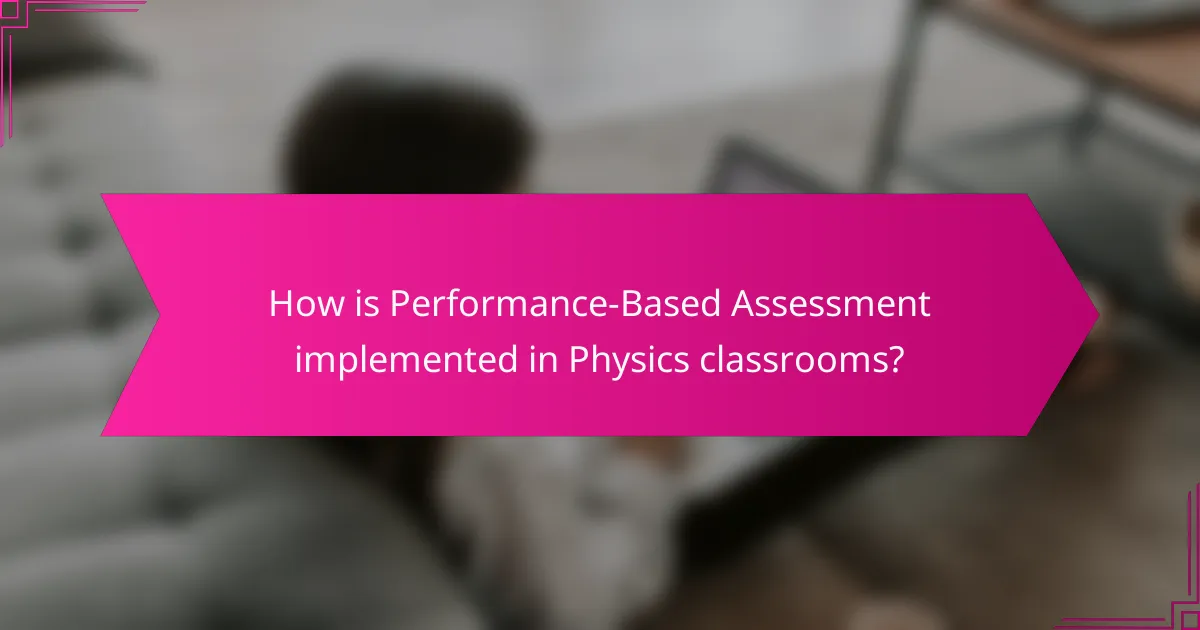
How is Performance-Based Assessment implemented in Physics classrooms?
Performance-Based Assessment in Physics classrooms is implemented through hands-on experiments and real-world problem-solving tasks. Teachers design assessments that require students to demonstrate their understanding of physics concepts in practical situations. These assessments often include lab activities, projects, and presentations. Students may work individually or in groups to complete these tasks. The emphasis is on applying theoretical knowledge to practical scenarios. Rubrics are commonly used to evaluate students’ performance based on specific criteria. This approach encourages critical thinking and collaboration among students. Research shows that performance-based assessments can enhance student engagement and retention of knowledge in physics.
What steps should educators take to design a Performance-Based Assessment?
Educators should follow a structured process to design a Performance-Based Assessment. First, they must define clear learning objectives aligned with curriculum standards. Next, they should identify the skills and knowledge students need to demonstrate. Then, they create authentic tasks that reflect real-world applications of those skills. After that, educators develop assessment criteria to evaluate student performance. It is also essential to provide students with clear instructions and expectations for the assessment. Finally, they should pilot the assessment to gather feedback and make necessary adjustments. Research indicates that well-designed performance assessments can enhance student engagement and learning outcomes.
How can learning objectives be aligned with assessment tasks?
Learning objectives can be aligned with assessment tasks by ensuring that assessments directly measure the knowledge and skills outlined in the objectives. This alignment involves mapping each learning objective to specific assessment criteria. For example, if a learning objective is to understand Newton’s laws of motion, the assessment could include practical experiments demonstrating these laws. Clear rubrics should be developed to evaluate student performance against the objectives. Research shows that aligned assessments improve student outcomes and engagement. A study by Black and Wiliam (1998) found that formative assessments aligned with learning goals significantly enhance student learning.
What role does feedback play in the implementation process?
Feedback is crucial in the implementation process as it provides essential information for improvement. It helps identify areas of success and those needing adjustment. Feedback can guide instructional strategies and enhance student learning outcomes. In performance-based assessments, timely feedback allows educators to refine their approaches. Research shows that effective feedback can increase student engagement and motivation. According to Hattie and Timperley’s work, feedback significantly influences student achievement. The implementation process benefits from structured feedback mechanisms to ensure continuous improvement.
How can technology enhance Performance-Based Assessment in Physics?
Technology can enhance Performance-Based Assessment in Physics by providing interactive simulations and real-time data analysis. These tools allow students to engage in hands-on experiments virtually. For instance, platforms like PhET offer simulations that replicate complex physics concepts. This accessibility helps students visualize and understand abstract theories. Additionally, technology enables immediate feedback through automated assessments. Research shows that timely feedback improves learning outcomes. A study by Hattie and Timperley (2007) highlights the significance of feedback in educational settings. Furthermore, technology facilitates collaborative learning through online platforms. Students can work together on projects, sharing data and insights. This collaboration fosters deeper understanding and critical thinking skills. Overall, technology transforms traditional assessments into dynamic, interactive experiences.
What tools and platforms are available for Performance-Based Assessment?
Performance-Based Assessment utilizes various tools and platforms to evaluate student skills. Common platforms include Google Classroom, which facilitates assignment submissions and feedback. Edmodo provides a collaborative space for sharing resources and assessments. Additionally, platforms like Seesaw allow for digital portfolios showcasing student work. Other tools include Rubistar for creating rubrics and Kahoot! for engaging assessments. These tools enhance the assessment process by enabling real-time feedback and tracking student progress effectively.
How does technology facilitate data collection and analysis?
Technology facilitates data collection and analysis by providing tools that automate and streamline these processes. Digital sensors capture real-time data in physics experiments. Software applications analyze large datasets quickly and accurately. Cloud computing allows for storage and easy access to data from multiple locations. Data visualization tools help interpret complex information through graphical representations. Machine learning algorithms can identify patterns and trends within the data. These technologies enhance the efficiency and accuracy of performance-based assessments in physics. Studies show that technology integration in education improves data-driven decision-making.
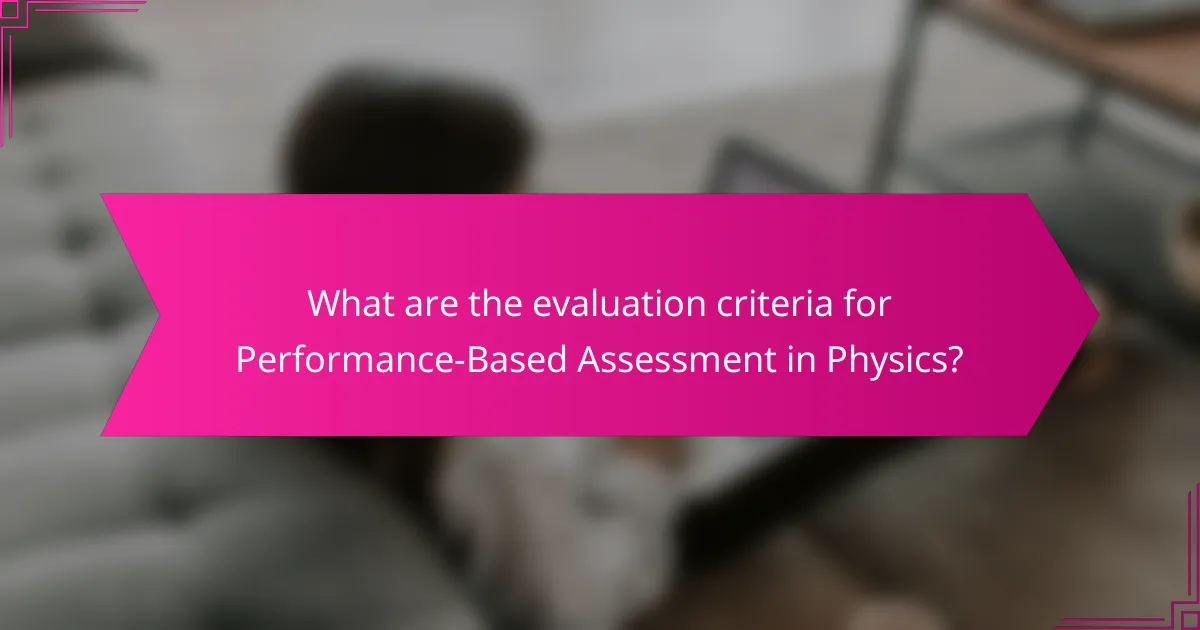
What are the evaluation criteria for Performance-Based Assessment in Physics?
The evaluation criteria for Performance-Based Assessment in Physics include several key factors. These factors assess students’ understanding and application of physics concepts. Criteria often focus on the accuracy of results, clarity of communication, and demonstration of problem-solving skills.
Additionally, students are evaluated on their ability to conduct experiments and analyze data. The use of appropriate scientific methods and tools is also considered. The criteria may include teamwork and collaboration, especially in group assessments.
Finally, adherence to safety protocols during experiments is a critical evaluation point. These criteria ensure a comprehensive assessment of students’ physics knowledge and skills.
What standards should be used to assess student performance?
The standards used to assess student performance should include clear learning objectives, formative assessments, and summative assessments. Clear learning objectives define what students are expected to know and be able to do. Formative assessments provide ongoing feedback during the learning process. Summative assessments evaluate student learning at the end of an instructional unit.
In physics education, the Next Generation Science Standards (NGSS) serve as a framework for these assessments. NGSS emphasizes scientific practices, crosscutting concepts, and disciplinary core ideas. This comprehensive approach ensures that assessments are aligned with the skills and knowledge students need to demonstrate.
Research has shown that performance-based assessments can enhance student engagement and understanding. A study by Wiggins (1998) highlights that authentic assessments reflect real-world applications of knowledge. Therefore, utilizing these standards leads to a more accurate evaluation of student performance in physics.
How can rubrics be effectively utilized in Performance-Based Assessment?
Rubrics can be effectively utilized in Performance-Based Assessment by providing clear criteria for evaluating student performance. They outline specific expectations for tasks, which helps students understand what is required. Rubrics also promote consistency in grading by standardizing evaluation across different assessors. Additionally, they facilitate feedback by highlighting areas of strength and improvement. Research shows that rubrics enhance student learning by making assessment criteria transparent, leading to better performance outcomes. For example, a study by Andrade (2000) found that students who used rubrics showed significant improvement in their work quality.
What metrics are essential for evaluating the outcomes of assessments?
Essential metrics for evaluating the outcomes of assessments include reliability, validity, and fairness. Reliability measures the consistency of assessment results over time and across different contexts. Validity assesses whether the assessment accurately measures what it intends to measure. Fairness ensures that the assessment is unbiased and equitable for all test-takers. Additionally, performance metrics such as student engagement, mastery of content, and critical thinking skills are crucial. These metrics provide insights into both student learning and the effectiveness of the assessment itself.
How can educators ensure fairness and objectivity in evaluation?
Educators can ensure fairness and objectivity in evaluation by using standardized assessment criteria. This involves developing clear rubrics that outline expectations for performance. Consistent application of these rubrics across all students minimizes bias. Utilizing multiple evaluators can further enhance objectivity by providing varied perspectives. Regularly reviewing and updating assessment tools ensures they remain relevant and fair. Training educators on implicit bias can also improve evaluation practices. Research shows that structured assessments lead to more equitable outcomes. For example, a study published in the “Journal of Educational Psychology” found that clear criteria significantly reduced grading discrepancies.
What strategies can be employed to minimize bias in assessments?
Employing standardized rubrics is a strategy to minimize bias in assessments. Standardized rubrics provide clear criteria for evaluation. This clarity helps ensure consistent grading across different assessors. Training assessors on these rubrics further reduces subjectivity. Incorporating multiple assessors can also mitigate individual biases. Using anonymous submissions prevents biases related to identity. Regularly reviewing and updating assessment criteria helps maintain fairness. Research indicates that structured assessments enhance objectivity in grading. These strategies collectively contribute to a more equitable assessment environment.
How can peer assessment contribute to the evaluation process?
Peer assessment enhances the evaluation process by providing diverse perspectives on student performance. It encourages active engagement among students, fostering critical thinking and reflective learning. Through peer feedback, learners can identify strengths and areas for improvement in their work. Research indicates that peer assessment can lead to improved understanding of assessment criteria and learning objectives. A study by Topping (1998) found that students who participate in peer assessment often achieve higher academic outcomes. This collaborative approach also promotes a sense of accountability and responsibility among peers. Overall, peer assessment serves as a valuable tool in the performance-based evaluation process in education.
What best practices should educators follow for effective Performance-Based Assessment?
Educators should follow several best practices for effective Performance-Based Assessment. First, they must clearly define learning objectives. This ensures that assessments align with desired outcomes. Next, educators should design tasks that reflect real-world applications. Such tasks engage students and enhance relevance.
Additionally, providing clear rubrics is crucial. Rubrics outline expectations and criteria for success. This transparency helps students understand how their work will be evaluated. Regular feedback throughout the assessment process is also important. Feedback supports student growth and improvement.
Finally, incorporating self-assessment encourages reflection. This practice helps students take ownership of their learning. Research shows that effective Performance-Based Assessment leads to deeper understanding and retention of material.
How can ongoing professional development support educators in this assessment approach?
Ongoing professional development supports educators in performance-based assessment by enhancing their instructional skills. It provides educators with updated strategies and techniques tailored for effective assessment. This training enables teachers to implement performance-based tasks more effectively. Professional development also fosters collaboration among educators to share best practices. Research shows that teachers who engage in continuous learning improve student outcomes. For instance, a study by Darling-Hammond et al. (2017) found that professional development significantly boosts teacher effectiveness. This, in turn, leads to improved student performance in physics assessments. Therefore, ongoing professional development is crucial for educators in adopting performance-based assessment approaches.
What tips can enhance the overall effectiveness of Performance-Based Assessment in Physics?
Incorporating real-world applications enhances the effectiveness of Performance-Based Assessment in Physics. This approach engages students by connecting theoretical concepts to practical scenarios. Utilizing collaborative projects fosters teamwork and encourages peer learning. Clear rubrics provide transparency in assessment criteria, helping students understand expectations. Offering timely feedback allows for continuous improvement and learning. Integrating technology can facilitate innovative assessment methods, such as simulations. Aligning assessments with learning objectives ensures that evaluations are relevant and meaningful. Lastly, providing opportunities for self-assessment encourages reflection and personal growth in students.
Performance-Based Assessment in Physics is an evaluation method that measures students’ understanding through practical tasks, emphasizing real-world applications of knowledge and skills. This article provides an overview of the implementation and evaluation criteria associated with this assessment approach, highlighting its differences from traditional methods, key characteristics, and components. It discusses the importance of performance-based assessments in enhancing student engagement and learning outcomes, as well as the challenges educators face in implementing them effectively. Additionally, the article outlines best practices for designing assessments, ensuring fairness in evaluation, and leveraging technology to improve the assessment process.
